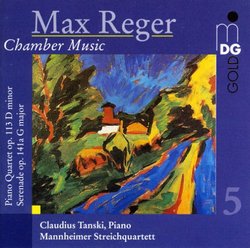| All Artists: Max Reger, Mannheimer Streichquartett, Claudius Tanski Title: Reger: Chamber Music, Vol. 5 Members Wishing: 0 Total Copies: 0 Label: MD&G Records Release Date: 11/19/1996 Genre: Classical Styles: Chamber Music, Historical Periods, Classical (c.1770-1830), Modern, 20th, & 21st Century Number of Discs: 1 SwapaCD Credits: 1 UPC: 760623071527 |
Search - Max Reger, Mannheimer Streichquartett, Claudius Tanski :: Reger: Chamber Music, Vol. 5
 | Max Reger, Mannheimer Streichquartett, Claudius Tanski Reger: Chamber Music, Vol. 5 Genre: Classical
|
Larger Image |
CD Details |
CD ReviewsMax Reger Sturm und Drang Christopher M. Lovett | Greater Boston, USA | 12/30/2004 (5 out of 5 stars) "Of Max Reger's two piano quartets, the D Minor is the less approachable but more ambitious and, in some ways, more rewarding. Taking the Brahms C Minor Piano Quartet as a point of departure, Reger goes farther in stretching the edge of tonal coherence. Compared with Reger's later Piano Quartet in A Minor, there are more disruptive contrasts, and a wider range--from loud, explosive dissonance to pockets of almost catatonic repose. This is music that demands attentive listening, and the reward is sometimes the pleasure of focusing on a passage while being almost totally adrift as far as knowing its place in the structure of a movement. These moments are sometimes better understood as atmosphere (not totally unlike the "non-functional" harmonies of musical "Impressionism") than as dramatic junctures. And, for all Reger's notorious "conservativism," it is a work like the D Minor Piano Quartet that most readily vouches for his appeal to atonal composers in the Schoenberg camp.
Despite the dangers of getting lost in the parts, Claudius Tanski and the Mannheimer String Quartet do a good job of making the work into a whole. The sound quality is superb. The piano and strings are well balanced. The piano sound is captured in sharp focus, but still allowed to breathe. The piano and strings also sound is if they're all close by, coming from the same accoustic. This works wonderfully in some of the delicate interlacing called for in the music, as well as in passages that have to be more nettlesome. Reger may not have used "Sturm and Drang" to characterise the D Minor Piano Quartet, but he did use another label for this piece and other works he wrote around 1910. As with Haydn, the more abrasive period would give way to music that, superficially at least, seemed much more effortless for the composer and listener. In Reger's case, this was the "Jena" style, which includes the A Minor Piano Quartet and the Serenade, Op. 141a. The lightness of the latter work is even more conspicuous, and the first movement, in particular, sounds like the deliberate evocation of another musical era, not unlike Prokofiev's Classical Symphony. In the first movement of Op. 141a, the flavor is Rococco, and the playing is airy but vigorously mercurial. This approach allows us to perceive the mask adopted by Reger (as he so often adopted the mask of the Baroque and pedagogical) but, even more so, his own transformation of tradition into music of another moment. The work begins by asserting a tie to the tradition of the serenade (the elevator music of the 18th century) then, especially in the slow movement, straying into new territory. " |

 Track Listings (7) - Disc #1
Track Listings (7) - Disc #1